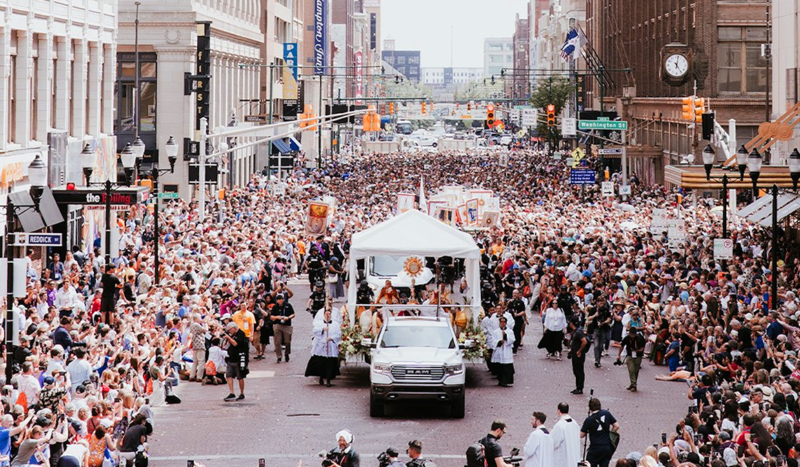
National Eucharistic Revival / Facebook
CV NEWS FEED // The National Eucharistic Congress has announced key details about its second National Eucharistic Pilgrimage, which will launch this Sunday from St. John’s Parish in Indianapolis and conclude on Corpus Christi Sunday, June 22, in Los Angeles.
In a May 13 press briefing, organizers outlined the mission and spiritual vision of the 2025 pilgrimage, including key stops across the country. This year’s route is placed under the patronage of St. Katharine Drexel, chosen for her Eucharistic devotion and her ministry to marginalized communities, particularly black and indigenous Americans.
Several planned pilgrimage stops have direct ties to St. Katharine Drexel’s legacy, including St. Monica’s Church and School in Kansas City, Missouri, which she helped establish and which continues to serve black Catholics today; schools she founded and visited in the Diocese of Tulsa, Oklahoma; and the Diocese of Gallup, New Mexico, which she helped to found and which ministers to many Indigenous Catholics.
Maria Benes, director of pilgrimages for the National Eucharistic Congress, shared that the perpetual pilgrims will stop at the halfway point in the Archdiocese of Oklahoma City, Oklahoma, to pray before an altar where St. Katharine Drexel once prayed and ask her intercession for continued grace on the journey.
The pilgrimage features eight young adult “perpetual pilgrims” who will accompany the Eucharist on foot from Indianapolis to Los Angeles, offering public witness and personal testimony along the way.
Many of the pilgrims are college students or recent graduates, including Stephen Fuhrmann and Charlie McCullough from Texas, Frances Webber from Minnesota, Ace Acuña from Nevada, and Leslie Reyes-Hernandez from Arizona, and Rachel Levy, Johnathan Hernandez, and Cheyenne Johnson from Indiana.
United by a deep love for the Eucharist and a desire to share Christ’s presence with others, the pilgrims spoke of the experiences that inspired them to make the journey.
For Levy, a moment of adoration after Mass in Bloomington played a pivotal role.
“I just knew the Lord was telling me that he loved me … in the worst of the worst of my sin,” she said. “His love is constant.”
Others spoke of their desire to give up worldly pursuits to serve Christ with greater abandon.
Hernandez, a 23-year-old from Fort Wayne, described leaving behind career expectations to follow God’s call: “Lord, here it is, here I stand, and do with it as you will.”
The pilgrimage includes public events, private retreats, and Eucharistic processions in dioceses across the country. Organizers encouraged all Catholics — regardless of whether they are physically able to attend events along the route — to participate spiritually. Faithful are invited to submit prayer intentions via the National Eucharistic Congress website, which will be physically carried to the final Mass in Los Angeles.
Organizers explained that this year’s priest chaplains will come from the Franciscan Friars of the Renewal and the Capuchins. Benes noted that the pilgrimage often draws Franciscan volunteers, likely due to its “charism [that] tends to be very Franciscan,” marked by “a lot of adaptability [and] adventures with Jesus along the road.”

